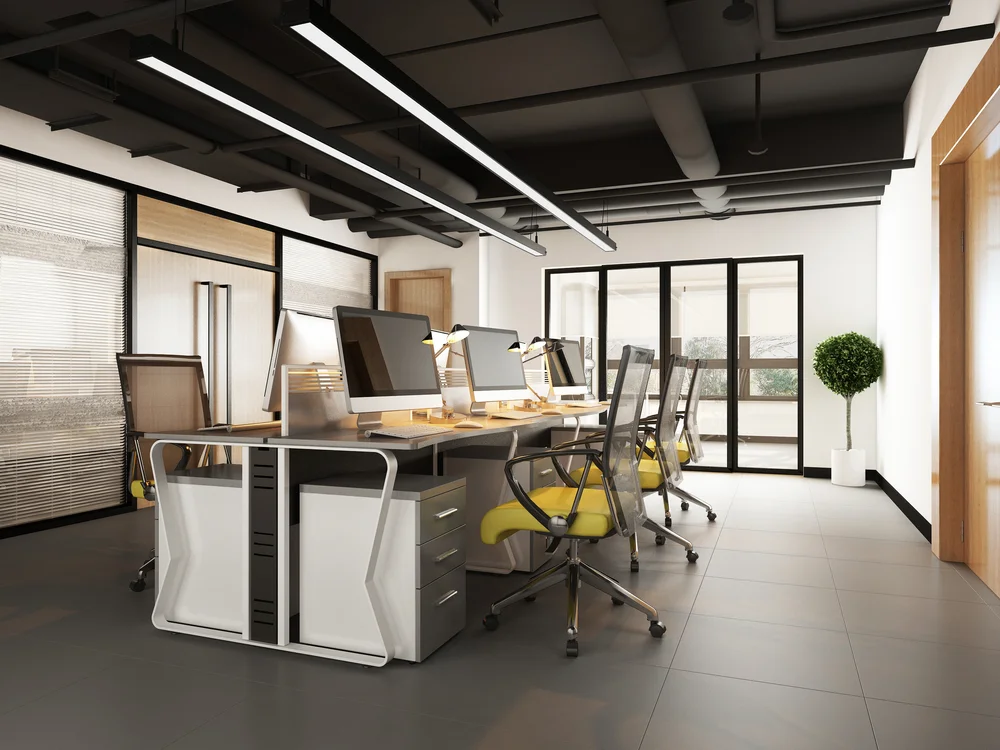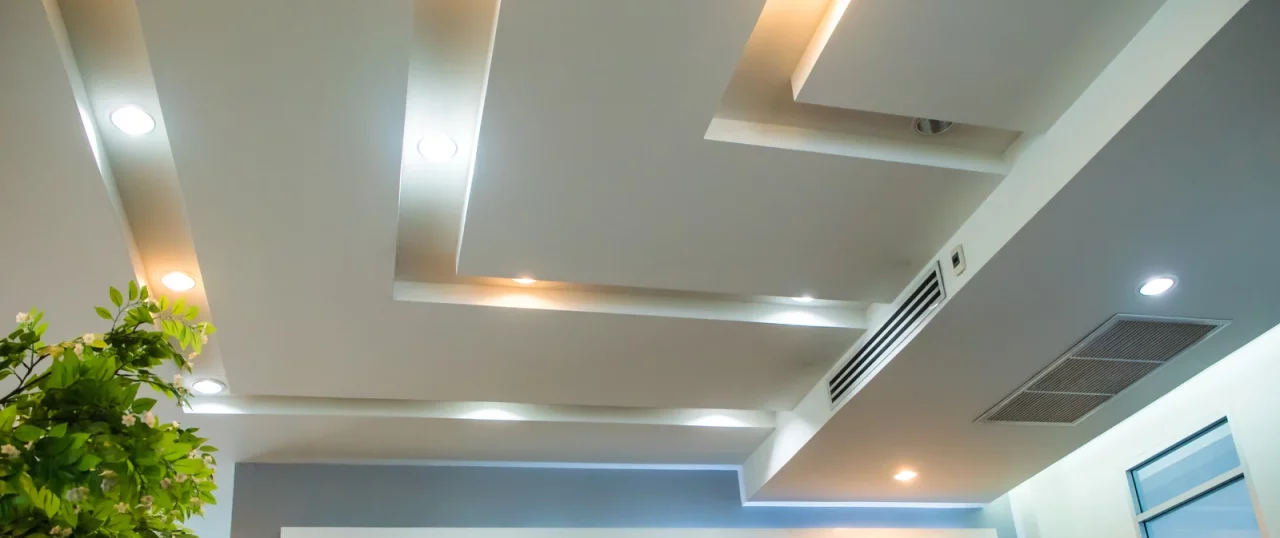4 Common Office Lighting Mistakes and How to Avoid Them
Proper lighting for office spaces plays a crucial role in productivity, comfort, and health. However, companies tend to make common mistakes when it comes to proper office lighting, such as not controlling the color of the lighting, not ensuring the capitalizing on natural lighting, and limiting customization options.
Not only are there federal regulations relating to proper lighting for office environments, but the right type of lighting can positively impact:
- Mood
- Energy levels
- Productivity
- Efficiency
So, what are the four common office lighting mistakes, and how can you avoid them?

Four common mistakes in office lighting
This office lighting guide will review the four common mistakes made with office lighting.
Mistake #1
The biggest mistake is an over-reliance on overhead lighting. When offices rely entirely on overhead lights, it can create a lot of glare, especially on computer screens and other laminate surfaces. This also leads to uneven lighting throughout the workspace. When lighting is uneven, employees cannot maximize the entirety of the workspace because there are certain areas where it’s not as comfortable to see what they are doing.
- Solutions: Incorporating task lighting and using diffusers on overhead fixtures to distribute light more evenly.
Mistake #2
The second mistake offices tend to make is ignoring natural light. Natural light in office spaces has a significant impact on the following:
- Productivity
- Energy levels
- Mood
- Workplace satisfaction
- Emotional regulation
- And more
Not utilizing natural light and work spaces is detrimental to any company. Natural light should be incorporated in the primary workspaces as much as possible. Where there is natural light, you also have to modify the lighting systems. You have to strategically brighten any areas that are untouched by window treatments or other bright surfaces.
This type of adjustment to the layout of the space as well as window treatments can encourage natural light without creating blinding glares off of bright, laminate surfaces or wooden desks, and also avoiding areas of the work space that are in severe shadow.
- Solutions: Strategies for maximizing natural light through window treatments, layout adjustments, and reflective surfaces.
Mistake #3
Another common mistake is using the incorrect color temperature. Color temperature is usually defined as warm or cool and is listed on the box for light bulbs. Color temperature corresponds to different levels of natural light that you would get outside, contingent upon the time of day.
For example, warmer light has a yellow tint, intended to mimic the light you get around sunrise and sunset, whereas cooler light has a blue tint, intended to mimic the bright light of a midday sun.
Many people apply this type of color temperature to their home life, installing warmer colors for small table lamps next to the bed so they can read without bright blue light in their eyes, but many people fail to incorporate it in the office.
Color temperature has a direct impact on focus and comfort. Places like break rooms might need warmer lights so that people can relax and feel at ease, but in the workspace, when people need higher levels of focus and attention, they need brighter, cool lights that represent the type of lighting you would get in the middle of the day when your energy levels are highest.
- Solutions: Choosing the right color temperature for various office areas (e.g., warm lights for break rooms and cool lights for workspaces).
Mistake #4
The fourth common mistake is neglecting lighting flexibility and control. It’s important that you have adjustable lighting in order to accommodate different tasks and personal preferences. For example, in a conference room, lighting controls can make it easier to change the light in the room in order to adjust for a presentation, a meeting with clients, or a group project.
Moreover, individuals have personal preferences when it comes to the lighting in their workspace and if you can offer lighting flexibility and control, they can make changes based on how bright the space is, how much natural light is coming in throughout the day, and how bright they want that space for themselves.
- Solutions: Install dimmers, offer personal task lights, and consider smart lighting systems for more control.

Importance of lighting maintenance and upgrades
If you neglect office maintenance and office lighting, it can lead to issues like:
- Inefficient lighting
- Increased energy costs
- Reduced employee satisfaction
This happens for myriad reasons; firstly, light bulbs might start to burn out, dim, or fade, and if this happens and no maintenance or upgrades take place, the inefficient lighting could put a strain on visibility in the space, safety, and employee productivity. Increased eye strain from looking at computers under poor lighting can lead to employee burnout and result in low retention.
In some cases, regular maintenance and upgrades have to take place for bright office lighting because previously unused or underused spaces are now accommodating more employees, which means desk arrangements change or floor plans open up, necessitating changes to the lighting in order to accommodate the increased number of employees.
Recommendations for proper lighting for office spaces
This office lighting guide wouldn’t be complete without recommendations. If you are trying to ensure that your office space has proper lighting, you can follow these three tips:
Tip #1
The first recommendation is to schedule regular inspections and clean your light fixtures. The buildup of dust and other debris over time can not only compromise the health and safety of your office space but also diminish the quality of the lighting in the room. Simple cleanings can go a long way toward brighter lighting. Regular inspections can also catch things like dim bulbs, burned-out bulbs, or areas that aren’t utilizing as much lighting as they need for the number of employees.
Tip #2
The second tip is to replace outdated bulbs with energy-efficient LED options. If you have taken over the rental space or purchased a new building for your company, you should always have the lighting inspected and upgraded. You may not know the last time the light bulbs were replaced, and you could be working with yellow, incandescent bulbs that are not conducive to quality lighting and productivity in an office space.
Tip #3
Consider smart lighting systems for greater control and customization. Professional companies can install smart lighting systems in your office that control the brightness based on the time of day and any natural light through the windows. These systems can also provide regular upgrades on maintenance needs and offer controls that maximize your energy consumption and costs.
Summing Up
Overall, many companies make several key office lighting mistakes, but thankfully, there are actionable strategies you can employ to avoid them. To make the most of bright office lighting and ensure that you have proper lighting for office spaces regardless of their purpose, you should regularly assess and refine your strategy, have regular inspections completed, and install systems that offer greater customization. All of this can lead to a productive and healthy work environment.
